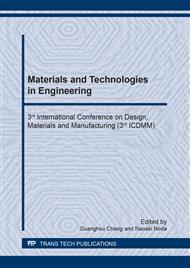[1]
M. M. W. e. al, Recycled concrete: a review, ALCONPAT, pp.235-248, (2015).
Google Scholar
[2]
G. B.M., Construction and technology, green certification, pp.40-43, (2008).
Google Scholar
[3]
S. d. M. A. ,Minimization and management of construction waste, diagnosis 2002, p.56, (2002).
Google Scholar
[4]
J. A. C. García y R. V. Yáñez, Recycled concrete, Instituto Politecnico Nacional, (2004).
Google Scholar
[5]
SEMARNAT, «NOM161-SEMARNAT-2011,» (2011).
Google Scholar
[6]
I. M. Daniel, Current situation of construction and demolition waste (CDW) and correct management for the process of recycling in the Mexican industry, Mexico DF., (2013).
Google Scholar
[7]
J. a. G. W. S. Brandon, Laboratory characterization of recycled concrete for use as pavement base material, Transportation Research Board, nº 1952, pp.21-27, (2006).
DOI: 10.1177/0361198106195200103
Google Scholar
[8]
S. A. D. Adam J. Kardos a, Strength, durability, and environmental properties of concrete utilizing recycled tire particles for pavement applications, Construction and Building Materials, nº 98, pp.832-845, (2015).
DOI: 10.1016/j.conbuildmat.2015.08.065
Google Scholar
[9]
A. Pasandín y I. Pérez, Overview of bituminous mixture made with recycled concrete aggregates.
Google Scholar
[10]
I. P. Pérez, A. M. R. Pasandín y J. G. Medina, Mezclas asfálticas dosificadas con RCD para carreteras de bajo tráfico, Coruña, (2016).
Google Scholar
[11]
S. Paranavithana y A. Mohajerani, The effects of mixing and compactation on volumetric properties of an asphalt concrete containing recycled concrete agregates, Australian Geomechanics Vol 38 No 2, pp.59-64, (2003).
Google Scholar
[12]
A. R. Pasandín, I. Pérez y B. Gómez-Meijide, Treatments applied to recycled concrete aggregates when used in hot mix asphalT, Coruña, (2014).
DOI: 10.4028/www.scientific.net/amr.849.81
Google Scholar
[13]
I. P. A. R. Pasandín, Effect of ageing time on properties of hot-mix asphalt containing, Elsevier- Construction and Buiolding Materials, nº 52, pp.284-293, (2014).
DOI: 10.1016/j.conbuildmat.2013.11.050
Google Scholar
[14]
A. M. Sumeda Paranavithana, Effects of recycled concrete aggregates on, Resources, Conservation and Recycling, nº 48, pp.1-12, (2006).
DOI: 10.1016/j.resconrec.2005.12.009
Google Scholar
[15]
J.-C. D. D.-H. S. Cheng-Hsiao Lee, «Evaluation of pre-coated recycled concrete aggregate for hot mix asphalt,Construction and Building Materials, nº 28, pp.66-71, (2012).
DOI: 10.1016/j.conbuildmat.2011.08.025
Google Scholar
[16]
A. P. L. M. I. Pérez, Hot mix asphalt using C&D waste as coarse aggregates, Materials and Design, nº 36, pp.840-846, (2012).
DOI: 10.1016/j.matdes.2010.12.058
Google Scholar
[17]
L. F. J. a. E. I.Moreno, Durability Indicators in High Absorption, Advances in Materials Science and Engineering, (2015).
Google Scholar
[18]
J. X. Z. S. S. K. S. P. S. Wengui Li, Interfacial transition zones in recycled aggregate concrete with different mixing approaches, Construction and Building Materials, nº 35, pp.1045-1055, (2012).
DOI: 10.1016/j.conbuildmat.2012.06.022
Google Scholar
[19]
K. T. A. N. H. K. Kiyoshi Eguchi, Application of recycled coarse aggregate by mixture to concrete construction, Construction and Building Materials, nº 21, pp.1542-1551, (2007).
DOI: 10.1016/j.conbuildmat.2005.12.023
Google Scholar
[20]
S. d. c. y. t. (SCT), Materiales pétreos para mezclas asfálticas, de materiales para pavimentos, Ciudad de México., (2008).
Google Scholar
[21]
SCT, Calidad de los materiales asfálticos, de Caracteristicas de los materiales, (2006).
Google Scholar
[22]
P. a. R. A. B. P. Tim Murphy, Marshall Mix Design, Schiller Park, Illinois 60176 U.S.A.: Humboldt Mfg. Co., (2008).
Google Scholar
[23]
ASTM, Standard test method for specific gravity and absortion of coarse aggregate.
Google Scholar
[24]
SCT, Calidad de mezclas asfálticas para carreteras, de caracteristicas de los materiales, (2008).
Google Scholar
[25]
SCT, Desgaste mediante la prueba de Los Ángeles de los materiales pétreos para mezclas asfálticas, de Materiales pétreos para mezclas asfálticas, (2002).
DOI: 10.20868/upm.thesis.14853
Google Scholar
[26]
SCT, Partículas alargadas y lajeadas de materiales pétreos para mezclas asfálticas (M-MMP-4-04-005/08), de Materiales pétreos para mezclas asfálticas, (2008).
DOI: 10.3989/mc.1949.i009.3406
Google Scholar
[27]
SCT, Equivalente de arena de materiales pétreos para mezclas asfálticas, de Materiales pétreos para mezclas asfálticas, (2002).
DOI: 10.15517/mym.v5i1.29703
Google Scholar
[28]
SCT, Viscosidad rotacional Brookfield de Cementos Asfálticos, de MMP. Métodos de muestreo y prueba de materiales, (2002).
Google Scholar
[29]
K. W. H. L. Z. D. Zhiqing Zhan, Key performance properties of asphalt mixtures with recycled concrete, Construction and Building Materials, nº 126, pp.711-719, (2016).
DOI: 10.1016/j.conbuildmat.2016.07.009
Google Scholar
[30]
A. P. I. Perez, Moisture damage resistance of hot-mix asphalt made with recycled, Journal of Cleaner Production, nº 165, pp.405-414, (2017).
DOI: 10.1016/j.jclepro.2017.07.140
Google Scholar
[31]
R. I. Saeed Fatemi, Performance evaluation of recycled asphalt mixtures by construction, Construction and Building Materials, nº 120, pp.450-456, (2016).
DOI: 10.1016/j.conbuildmat.2016.05.117
Google Scholar
[32]
T. Y. I. T. K. N. R. C. Yoon-Ho Cho, The Application of Recycled Concrete Aggregate (RCA) for Hot Mix Asphalt (HMA) base Layer Aggregate, KSCE Journal of Civil Engineering, nº 15, pp.473-478, (2011).
DOI: 10.1007/s12205-011-1155-3
Google Scholar
[33]
A. A. M. Arabani, The effect of recycled concrete aggregate and steel slag on the dynamic properties, Construction and Building Materials, nº 35, pp.1-7, (2012).
DOI: 10.1016/j.conbuildmat.2012.02.036
Google Scholar
[34]
Z. Y. *. Julian Mills-Beale 1, The mechanical properties of asphalt mixtures with Recycled Concrete Aggregates, Construction and Building Materials, nº 24, pp.230-235, (2010).
DOI: 10.1016/j.conbuildmat.2009.08.046
Google Scholar
[35]
M. B. REVUELTA, Manual of rcd and recycled aggregates, Madrid: Fueyo editores, (2010).
Google Scholar
[36]
M. S. D. Juan y M. P. A. Gutiérrez, Study on the properties of recycled aggregates. use in concrete structure, Madrid, España: Centro de publicaciones; Secretaría general técnica; ministerio de fomento; CEDEX, (2006).
Google Scholar
[37]
M. S. D. juan y P. A. Gutiérrez, Study on the properties of concrete manufactured with recycled aggregates , Madrid, España: centro de publicaciones; secretaria general técnica; Ministerio de fomento; CEDEX.
Google Scholar


